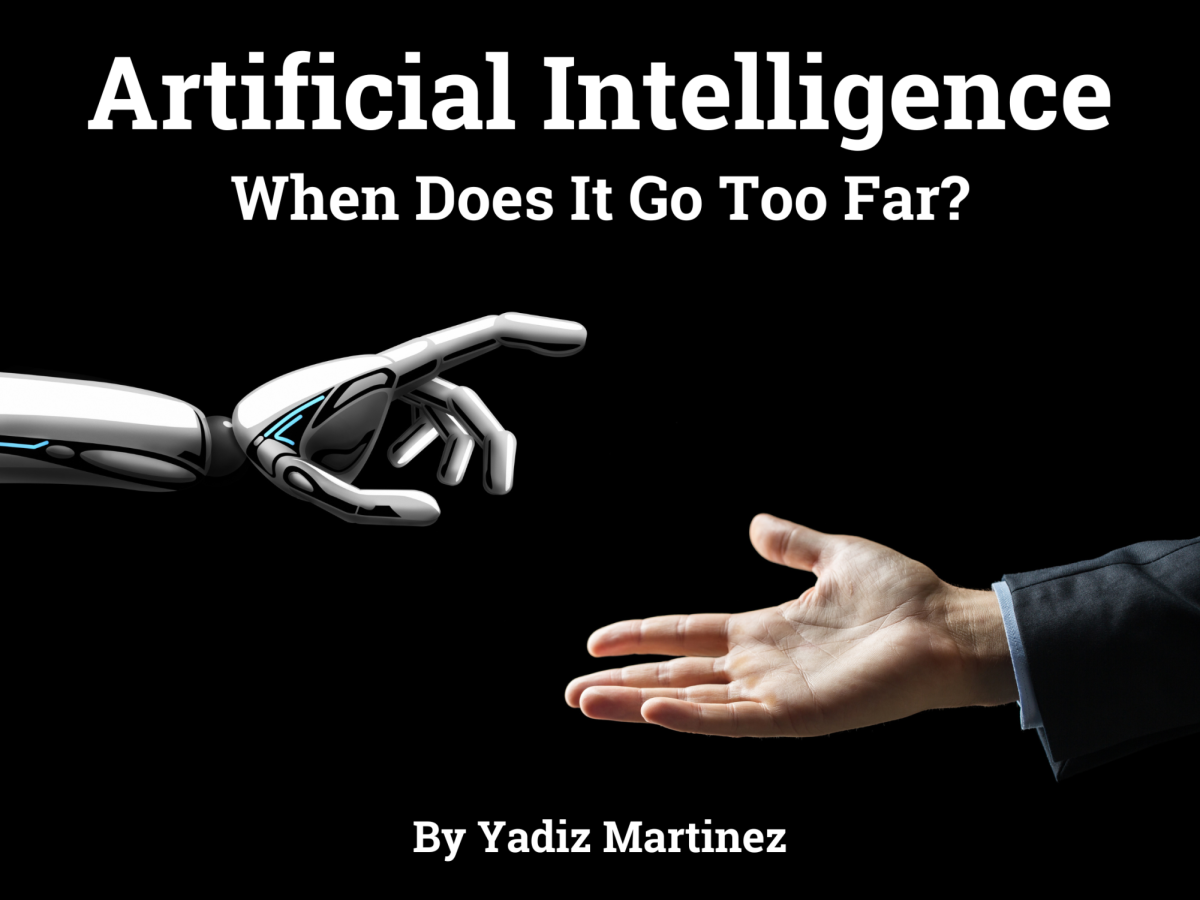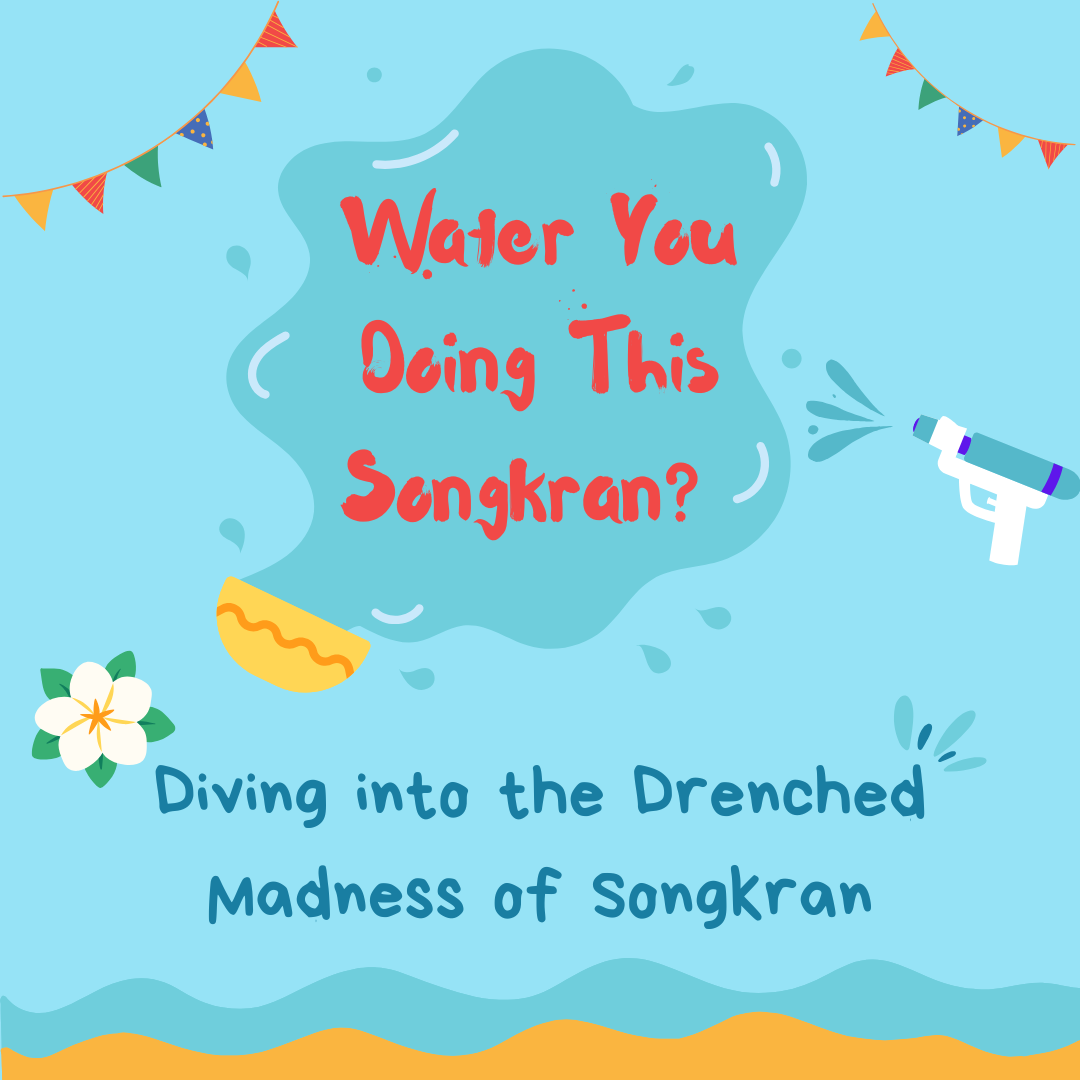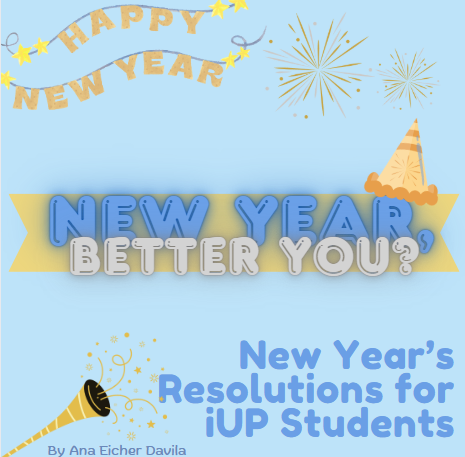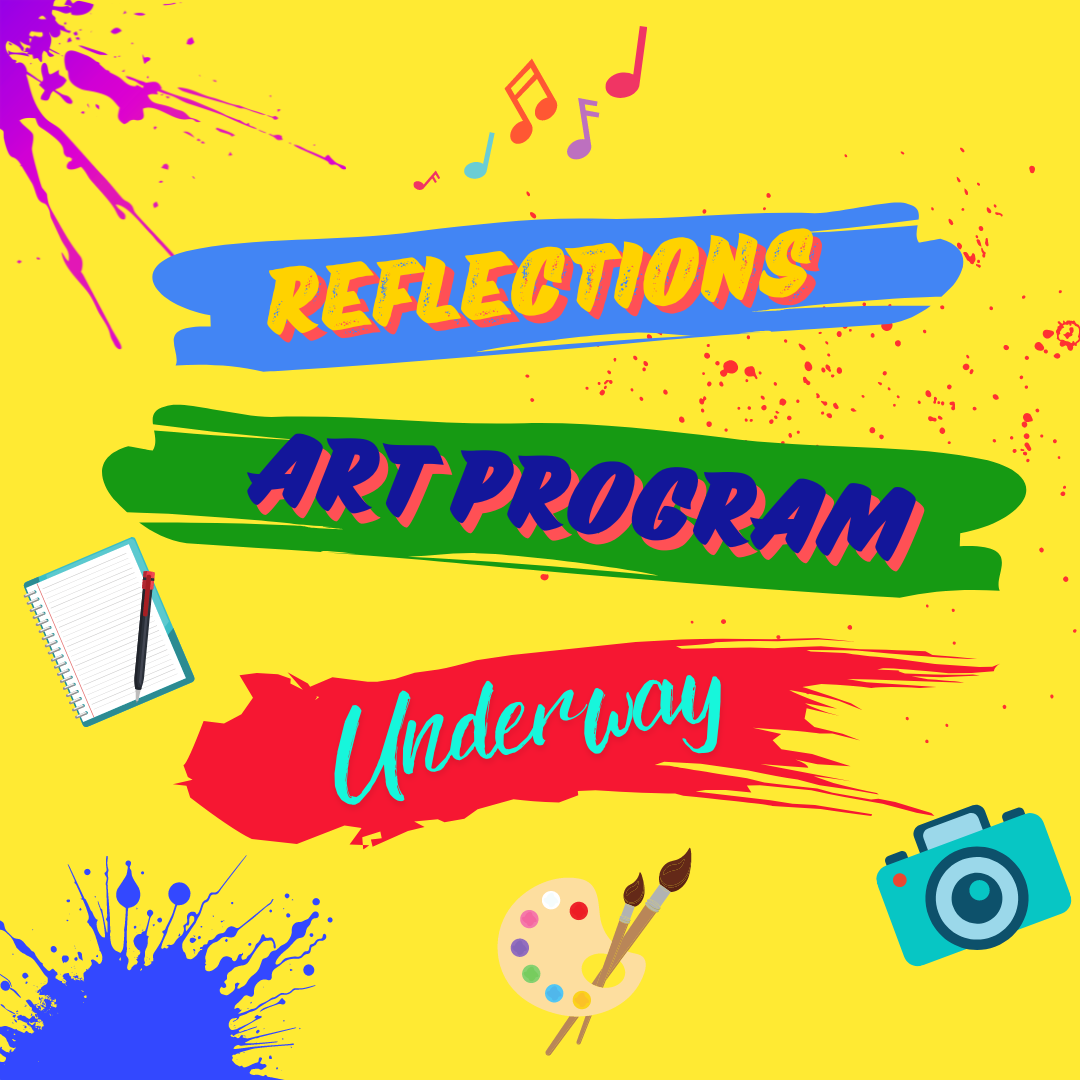Technology has become a pinnacle of our generation. At the click of a button or the swipe of a screen, you can find solutions to almost all of your problems. Artificial intelligence has even become a prevalent topic at iUniversity Prep that, whether you realize it or not, impacts the way we’re learning. However, the various developments and evolution of artificial intelligence has led to advancements that humans never thought possible, and we must begin to wonder, has artificial intelligence gone too far?
What is Artificial Intelligence?
A book definition of artificial intelligence (A.I.) could be similar to the Merriam Webster dictionary’s definition, which defines artificial intelligence as “the capability of computer systems or algorithms to imitate intelligent human behavior” (Merriam-Webster). Not all machines and technology are considered artificial intelligence, but those that do fall under the category have similarities to human intelligence, and are typically able to problem solve without having prior input on exactly how to solve the given problem or what the correct answer would be to the question. This definition of artificial intelligence, though, can seem a little underwhelming, considering everything that artificial intelligence has done up to this point in time.
Throughout many years of technological advancement, artificial intelligence has become a topic of interest due to its extensive ability to act human-like, as opposed to more common technology that does exactly as it is programmed to do. Over the last two to three decades, the thought of humanoid robots having the abilities to act in their own will and with their own thoughts has both fascinated and haunted people. However, artificial intelligence has been around for far longer than most people think it has, and it won’t be going away anytime soon.
Where Did It All Start?
Harvard University states that, “In the first half of the 20th century, science fiction familiarized the world with the concept of artificially intelligent robots. It began with the ‘heartless’ Tin man from the Wizard of Oz and continued with the humanoid robot that impersonated Maria in Metropolis” (Anoyah, 2017). The idea of robots and electrical devices with human intelligence then became a topic that philosophers, scientists, mathematicians, and more explored.
British polymath Alan Turing reasoned that robots could use previous information to make decisions, just like humans do (Anoyah, 2017). To expose his thoughts to the rest of the world, Turing wrote a paper in 1950 titled “Computing Machinery and Intelligence.” In his paper, Turing wrote about what kinds of machines/computers could be used to make artificial intelligence and how he thought he could test their knowledge.
Despite his ambition, Turing was unable to prove his theory (Anoyah, 2017). Computers around this time were extremely expensive, and more importantly, they could not store the commands they were given. This meant that a computer could execute a command, but would not be able to remember their past commands and the results/effects of completing the command. Both of these obstacles made it impossible for Turing to test his concepts and ideas.
Then, Allen Newell, Cliff Shaw, and Herbert Simon created Logic Theorist (Anoyah, 2017). Logic Theorist was a program created to imitate human intelligence, thinking, and problem solving skills. The expenses to make Logic Theorist were funded by RAND Corporation. This program was shown to scientists and researchers at the Dartmouth Summer Research Project on Artificial Intelligence in 1956, and it is still considered history’s first artificial intelligence program. The Dartmouth Summer Research Project was a conference hosted for renowned researchers in order to discuss artificial intelligence and the parameters for this new science field.
Contrary to their expectations, the conference was unsuccessful in discussing the practice of artificial intelligence (Anoyah, 2017). Nonetheless, they were still able to come to the conclusion that artificial intelligence was possible– one of the most insane ideas of that time. After the conference, from 1957 to 1974, artificial intelligence developed immensely (Hardesty, 2017). Computer systems could complete tasks faster than ever before, and they gained the capability to store information given to them.
Even with the advances in technology, dwindling funding and lack of results slowed down artificial intelligence research and development. That seemed like the end of artificial intelligence development, until the 1980’s, when the abilities of a computer expanded once more. Thanks to John Hopfield and David Rumelhart, “deep learning” was publicized. Deep learning is a computer’s ability to “learn” from data given to it, so that it can in turn relay the information to the person that asks for data from the computer (Hardesty, 2017). Nowadays, deep learning is still a network used by many artificial intelligence programs, but when it was first popularized, it wasn’t nearly as advanced as it is today.
Once again, funding and research went dry, leaving people on edge once more to see how artificial intelligence could further be improved. Surprisingly, artificial intelligence continued to develop through the 1990’s and into the 2000’s (Hardesty, 2017). Even with the lack of funding, grandmaster Gary Kasparov lost to IBM’s Deep Blue chess playing program, speech recognition software was developed and implemented into Windows. Kismet, a robot created and developed by Cynthia Breazeal, was able to recognize and display emotions (Anoyah, 2017). At that point in time, people wondered: what can’t artificial intelligence do?
Artificial Intelligence Today
In the years since the developments of artificial intelligence in the 2000’s, A.I. has reached new heights and done things people would have never imagined before. Not only has artificial intelligence developed speech, handwriting, image, and language recognition, it has actively branched out to art, writing, music, and more. The actions people have taken with artificial intelligence has led to questions about morally and/or ethically correct purposes for using artificial intelligence and how it can (and has) affected humans. While that is a valid topic, many people hold vastly different, sensitive opinions about artificial intelligence, so this topic will not be covered too in-depth.
An example of the advancements made in artificial intelligence was seen in the 2022 Colorado State Fair. One of the categories for the state fair art competition was digital art, and after reviewing the artwork, judges voted the submission of Jason Allen as the first place winner (Teoh, 2022). But there was something very different about this piece of art: a human had not made it. The entire piece of art was made by inputting several inquiries into AI Gigapixel and Midjourney, artificial intelligence platforms that create images based on the prompts given to it (Metz, 2022).
Following the first place award, Allen received a 300 dollar prize. His prize-winning art led to a debate within the art community. Many artists took to social media to express their opinions over whether this should be considered digital art in the first place, let alone if it should have won the competition. Some said that “typing keywords in a good enough sequence isn’t art” (Teoh, 2022) and “This is the literal definition of ‘pressed a few buttons to make a digital art piece’” (Metz, 2022).
Although many artists criticized Allen, he defends his A.I. art, claiming that “It’s not like you’re just smashing words together and winning competitions’.” Allen states that it took creative work, trial and error, and more than 900 prompts to create his final results, and therefore should be considered equal to the other artworks. Even so, a large majority of artists were opposed to the idea of A.I.-generated art and how it can (and is) negatively affect the art community.
For one, there are concerns over artists’ work being used to train (or feed) A.I. image generators without the consent of the artist. When their artwork is fed into these image generators, the users of text-to-image A.I. applications/platforms can ask for an image to be in the style of a particular artist, and the image generator will create an image based on the images it was trained by.
One artist, Erin Hanson, had her art style replicated in Stable Diffusion, an A.I. image generator, without her permission. Upon using Stable Diffusion with a CNN reporter, she was able to get images alarmingly similar to her own works of art (Metz, 2022). The main problem many people find with this, other than artists not being compensated or asked for their art, is that many of these A.I. image generators allow users to own and/or sell the images they create. Because of this, artists’ careers and income can greatly depend on the results achieved by A.I. image generators; creating an artificial image is often faster and cheaper than paying a human artist to create an image.
On the other hand, there are also multiple benefits to using A.I. art and images. Smaller businesses and people that can’t afford paying a graphic designer might opt for A.I.-generated images. Additionally, artificial images can be edited and changed easily, which contributes to the efficiency of artificial intelligence.
Moreover, artificial intelligence has been applied to music as well. According to Billboard, artificial intelligence has changed the way music is created and listened to. A.I. voice synthesis, which is fairly recent, allows singers to hear what songs will sound like sung by them without having to sing it themselves (Leight & Robinson, 2023). Furthermore, artificial intelligence has allowed people to split songs up into “stems,” which are the different parts of a song (the different instruments, singers, etc). Another notable change in the music industry is the assembling of digital beats, instruments, and vocals. A.I. software has made it possible for songs to be made within minutes; however, whether that is good or bad is subjective and remains to be seen.
One of the most noticeable changes to the world is artificial intelligence in writing. ChatGPT and ChatGPT-4 have been some of the most noticeable artificial intelligence writing generators. These A.I. writing generators are among many, but ChatGPT’s popularity is due to the extent of its knowledge, abilities, and responses.
With the capabilities of A.I. writing generators, many people have taken advantage of it for work, entertainment, and more. Its capabilities stretch beyond question answering, as writing generators like ChatGPT have the ability to write essays, stories, summarize, reword, and more. This makes it appealing to all types of people for different purposes (a lot of which would be too complicated to fit into a few paragraphs). Though, because of its capabilities, people have misused it, too.
An example of this is when students use it for their homework or assignments. It’s alarmingly easy to simply input your homework assignment and receive an answer. A professor at the University of Pennsylvania’s Wharton School of Business said that “You can paste in entire academic papers and ask it to summarize it. You can ask it to find an error in your code and correct it and tell you why you got it wrong, […] that is absolutely stunning” (Bowman, 2022).
This has made it difficult for teachers of all education levels to know what work is student-made and what work is artificially generated, leading to an increase in the use of artificial intelligence detectors as A.I.’s popularity rises. With this new technology, students have also been accused of using artificial intelligence to complete their assignment, even when they hadn’t used any A.I (Fowler, 2023). Both students and teachers have felt the drawbacks and negative effects of artificial intelligence in school, and artificial intelligence will continue to develop and change the lives of people, for better or worse.
iUniversity Prep’s Stance on Artificial Intelligence
iUniversity Prep’s academic integrity policy was updated last year to include rules over A.I.-created work, now stating that, “AI programs or generators (ChatGPT, ChatSonic, Wonder, etc) to compose or alter writing or other creative work is strictly prohibited”. Because iUniversity Prep is an online school, avoiding these artificial intelligence tools is something that students themselves need to monitor and make sure to avoid, as it is not allowed at iUP. In a completely virtual environment, it’s difficult to not marvel over the effects of artificial intelligence. With that in mind, what do iUP students think about artificial intelligence in art and literature?
The viewpoints of artificial intelligence were mixed. I asked iUP’s art club leaders about their opinion on artificial intelligence, and some students, such as Logen McAllister, think that “it can be useful as a tool to give you inspiration, or to potentially help you learn.” Other students, like A.S., said that, “I do think AI art can be beneficial when used as a tool and not used to create an entire body of work.” And while some students pointed out that art made by animals, not humans, is still “art”, all of the interviewed students agreed that art made by artificial intelligence is not “real” art.
In addition, I asked some members of iUP’s book club about their thoughts on A.I. in literature. Anna Lee Phillips says that she considers “a ‘real’ essay, poem, short story, etc. to be something written in an interesting [way] to communicate”, and personally she wouldn’t consider A.I.-generated stories “real” because “I imagine an actual person using their actual brain to share personal experiences”. An important part of literature that book club members agreed on was that A.I. writing generators don’t have a soul or human experience, and Anna Lee noted that, “As an avid reader, my favorites have been the writings with soul, meaning, and deep background, and A.I. would be able to give that to me in a natural way”.
Students like Cheyenne Gilmore say that A.I. doesn’t have its own personality and feelings yet, so she wouldn’t consider it to be a “real” piece of literature, but, “if we’re talking about AI that’s years away from where we are now, where they have personalities and experience (i.e. Data from Star Trek) then no, they don’t have to be human to write”. Finally, Cheyenne said that until artificial intelligence develops human feelings and emotion, “it has no life to it, it’s just someone else’s words mixed up on a page”.
Conclusion
With the many changes artificial intelligence has created, A.I. has led to good, bad, and strange outcomes. Who knows, maybe decades from now artificial intelligence will have its own defined sub genre of music, art and literature. While we cannot predict what artificial intelligence will do next, or how it might affect us in the future, it’s important to keep an open mind for the many more artificial intelligence advancements and developments that are surely to come.
Works Cited:
Anyoha, R. (2017, August 28). The History of Artificial Intelligence. Science in the News. https://sitn.hms.harvard.edu/flash/2017/history-artificial-intelligence/
Bowman, E. (2022). A new AI chatbot might do your homework for you. But it’s still not an A+ student. Retrieved from https://www.npr.org/2022/12/19/1143912956/chatgpt-ai-chatbot-homework-academia
Fowler, G. A. (2023). What to do when you’re accused of AI cheating. Retrieved from https://www.washingtonpost.com/technology/2023/08/14/prove-false-positive-ai-detection-turnitin-gptzero/
Leight, E., & Robinson, K. (2023). 5 ways AI has already changed the music industry. Retrieved from https://www.billboard.com/lists/ways-ai-has-changed-music-industry-artificial-intelligence/
Merriam-Webster. (n.d). Artificial intelligence. In Merriam-Webster.com dictionary. Retrieved October 20, 2023 from https://www.merriam-webster.com/dictionary/artificial%20intelligence
Metz, R. (2022, September 3). Ai won an art contest, and artists are furious . CNN. Retrieved November 10, 2022, from https://www.cnn.com/2022/09/03/tech/ai-art-fair-winner-controversy
Metz, R. (2022). These artists found out their work was used to train AI. now they’re furious | CNN business. Retrieved from https://www.cnn.com/2022/10/21/tech/artists-ai-images/index.html
Hardesty, L. (2017, April 14). Explained: Neural networks. MIT News | Massachusetts Institute of Technology. https://news.mit.edu/2017/explained-neural-networks-deep-learning-0414
Teoh, B. (2022, September 13). Art made by AI wins Fine Arts Competition. Impakter. Retrieved November 10, 2022, from https://impakter.com/art-made-by-ai-wins-fine-arts-competition/#:~:text=An%20artwork%20made%20by%20Artificial,used%20to%20compete%20in%20competitions
















Anika Goswami • Apr 9, 2024 at 8:15 pm
I love this article, very informative read!